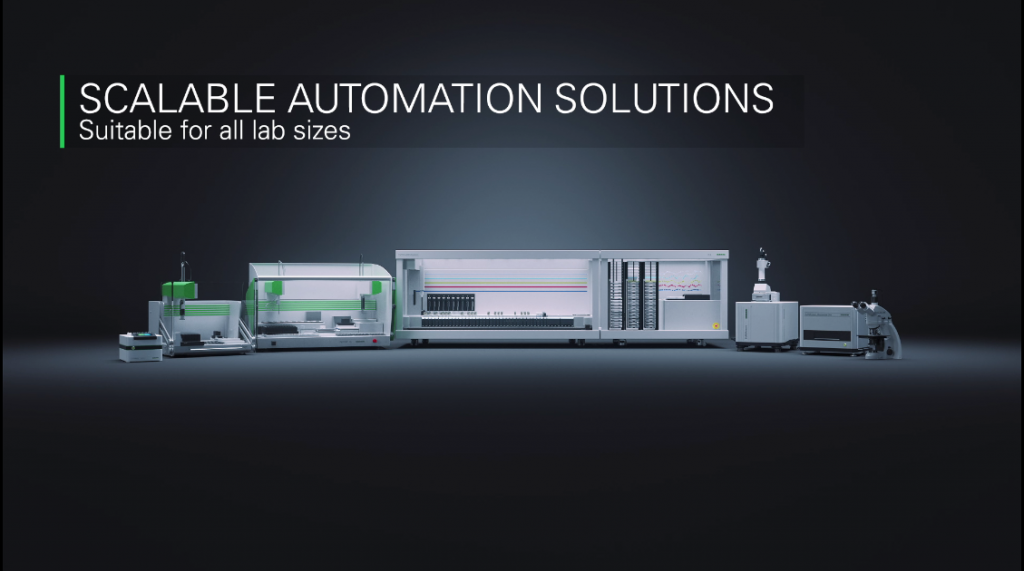Always the perfect match for the automation of your lab routine
EUROIMMUN has been building expertise in immunofluorescence diagnostics since the 1980s. The indirect immunofluorescence assay (IFA) serves as an essential screening method for detecting many types of autoantibodies. It offers a broad antigen spectrum due to the use of cells and tissues as antigenic substrates. Thanks to our in-house research and development as well as own production facilities, we are able to design optimal solutions to meet our customers’ needs.
One of EUROIMMUN’s first pioneering achievements was BIOCHIP Technology in 1983. Miniature sections of different substrates, the BIOCHIPs, are positioned side by side in the reaction fields of slides and can be incubated all at once under standardised conditions using the TITERPLANE Technique. BIOCHIP Mosaics enable comprehensive antibody profiles to be established with a single incubation. Today, we offer the largest portfolio of IFA substrate combinations on the market encompassing all kinds of diagnostics.
However, manual incubation of the slides and also traditional microscopic evaluation of the fluorescence patterns is time-consuming and demands high proficiency from laboratory staff. Moreover, evaluation is based on subjective interpretation by the lab technicians, which can lead to differing result interpretations.
Today’s laboratories have a variety of options for automated processing of IFA slides to improve the efficiency and standardisation of IFA. Our top-end instrument is the EUROLabWorkstation IFA which was introduced in 2019 and provides fully automated processing of IFA slides at a high throughput of more than 200 samples per hour. The system was developed with a focus on data integrity and minimisation of manual processes. Drawing on experience gained from previous milestones, we incorporated our proprietary TITERPLANE incubation and MERGITE! washing technologies to ensure brilliant fluorescence signals. The tabletop device MERGITE! enables fully automated slide washing with a controlled liquid flow which ensures meticulous washing that is gentle on the substrates, ensuring high-quality results.
Further instruments such as the IF Sprinter and Sprinter XL are available for smaller sample numbers. These devices are in use in 47 countries all over the world, and the 1000th device has recently been installed at a customer site.
Additionally, EUROIMMUN launched its first microscope tailored to indirect immunofluorescence in 2006. The simplified, low-maintenance design incorporated a controlled LED in place of conventional complex illumination fittings. With its long life span, low power consumption and regulated light intensity, the cLED brought a new level of reproducibility, cost-effectiveness and convenience to immunofluorescence microscopy. The cLED technology is now used in our EUROStar III Plus microscope, as well as in our highly successful EUROPattern series.
Computer-aided immunofluorescence microscopy using the EUROPattern system was a landmark development enabling complete on-screen evaluation of IFA and eliminating the need for a dark room. The EUROPattern Suite was introduced in 2011 in its first version and consists of a fully automated microscope with slide magazine accompanied by sophisticated software for image recording, IFA pattern interpretation and result archiving. The EUROPattern Microscope 1.5 model can process up to 500 fields containing multiple BIOCHIP substrates in one run. It has an image acquisition speed of 13 seconds per image, which established it as the frontrunner in speed. There are currently more than 500 installations of this microscope worldwide.
The EUROPattern Microscope Live was launched this year and is a compact model which combines state-of-the art live microscopy with ultrafast image processing for small- and medium-throughput laboratories. It incorporates novel laser focussing technology, which allows image acquisition in a record 2 seconds per image. It also features an automatic fluorescence calibrator, ensuring standardised light quality between microscopes even at different locations. For live microscopy a multi-touch screen on the monitor is included to allow easy navigation and zooming. The microscope hardware is complemented by the advanced EUROLabOffice 4.0 software, which provides complete management of analyses and results as well as image evaluation incorporating artificial intelligence (AI).
The software uses deep convolutional neural networks for discrimination of positive and negative results and pattern recognition. For example, in the evaluation of anti-nuclear antibodies (ANA) on HEp-2 cells, which is one of the most commonly performed analyses in autoimmune diagnostics, nine different patterns, including DFS 70 and AMA, as well as diverse combinations thereof can be identified to get the most accurate result proposal for every patient. The software also generates titer suggestions from the fluorescence intensities of the incubated dilutions. The ANA pattern classification is compliant with the International Consensus on ANA Patterns (ICAP). The classifier can also be used to evaluate anti-neutrophil granulocyte cytoplasmic antibodies on granulocyte substrates, anti-dsDNA antibodies on Crithidiae luciliae, autoantibodies associated with autoimmune liver diseases on tissue substrates and neuronal autoantibodies on recombinant cell substrates. Many more applications are under development to be added to the repertoire.
EUROLabOffice 4.0 is an evolution of our established EUROLabOffice middleware and was designed as a laboratory counterpart to Industry 4.0. In line with this, our focus lay on high interconnectivity for maximum data integrity and user convenience. The software serves as a flexible central interface, providing digital laboratory organisation with intelligent networking of workplaces and instruments, for example for IFA, ELISA, chemiluminescence and immunoblot. It can be connected to laboratories’ existing information systems, so that data can be exchanged securely and with complete traceability. The software has an intuitive interface, making it easy to use. For instance, the results window displays all findings consolidated into one report per patient, including the patient’s history and all images. The system also administers and archives all data, images, results and article information, creating paper-free processes. With its versatility and user friendliness, we consider EUROLabOffice 4.0 a significant milestone in the digitisation of the diagnostic laboratory.
